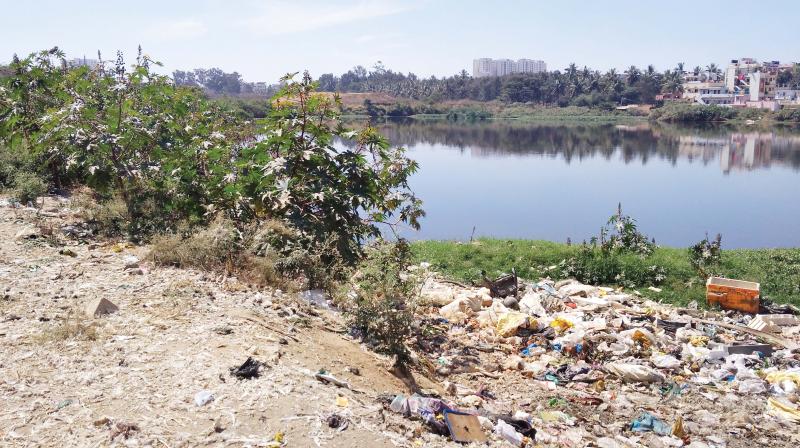Residents of Somasundarapalya: A bio-hazard zone

Bengaluru: The residents of Somasundarapalya claim that Karnataka Compost Development Corporation’s plant in the vicinity poses a fire risk as the plant has stored Refuse Derived Fuel (RDF) way beyond its capacity. Last year, the RDF stored in the plant caught fire, spreading panic among residents. In addition, the Somasundarapalaya lake has shrunk to one-fourth of its size from 16 acres to four acres, thanks to large-scale encroachments. The water body has also become an illegal garbage dumping area
With no sight of Refuse Derived Fuel being removed from the sight, the residents of Somasundarapalya claim they are sitting on a biological bomb. Last year in February, on Mahashivratri day there was a huge fire outbreak at the Karnataka Compost Development Corporation (KCDC).
The residents allege that the though the plant’s capacity is only 70 tonnes, the intake is around 180-200 tonnes. The KSDC, however, maintains that the plant’s capacity is 500 tonnes.
The Somasundarapalaya lake, the only water body in the vicinity, has shrunk from 16 acres 29 guntas to four acres and one gunta, thanks to encroachments. The lake has also become an illegal garbage dumping area and the residents allege that the leachate enters the water body.
The members of Kudlu, Haralukunte, Hosapalya, Somsundarapalya and Parangipalya (KHHSP) Resident Welfare Association have been fighting against the alleged violation of norms by the KCDC.
“KCDC chairman maintains that the plant was set up in 1975 and the apartments came much later. But does he not know that the occupancy certificates were given to all the apartments by the BBMP. Why do the authorities not talk about the lake encroachment?” said Kamesh Rastogi, a resident and member of KHHSP.
After the prolonged row between the officers of the regulating agencies and the residents, a Joint Action Team (JAT) was formed on September 16, 2017, comprising officials of BBMP, KCDC and the residents.
Though the team was expected to hold a meeting fortnightly, the residents say that now the meeting is conducted only on demand.
Rastogi also suggested that there are no Operation Managers of the plant. “Our movement is apolitical and every single party is responsible for the rot. We will only vote for the party who is will find a permanent solution to this menace,” said Krishna Kumar, another member of KHHSP.
Though in the JAT meeting the officials assured to end the stench by January 18, the problem persists with the foul smell affecting residential complexes within the radius of 1.5 kilometres.
The KCDC is tasked to remove 100 tonne of processed waste, out of which only 30 tonne is removed on a daily basis. “The RDF is covered with mud and size of the mound is increasing daily. In the past three years, the lake has been encroached and the condition has worsened,” said Lalithaamba, another member of KHHSP and a local resident.
‘Automatic sprayer will be installed to control odour’
Interview with BBMP Joint Commissioner, Bommanahalli Zone, Veerbadraswamy
The residents allege that the mound of RDF is not being removed as per the norms. Does the plant’s intake exceed capacity?
The average amount which we reduce is 50 tonnes daily and in the coming days, we will gradually increase it to 100. Our intake is 500 tonnes, but due to protests, we are only accepting 130 tonnes, which is hardly 26% of our capacity.
The stench emanating from the compost plant engulfs the area. Is the bio-filter effective?
Practically, the filter is running round the clock, but the workers in the plant feel uncomfortable, since the outlets remain closed. We have planned to erect 60-feet mesh with nets across the plant to prevent flies. The automatic spray would be installed to control the odour and the estimate of the entire project is Rs 3 crore. It would be ready by the end of this month.
The residents are planning to take out a rally on February 11. What is your message?
We have removed over one lakh litres of leachate from the old stock. Local people, barring few, are happy with the improvement we have shown in the past one year.

